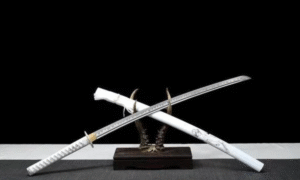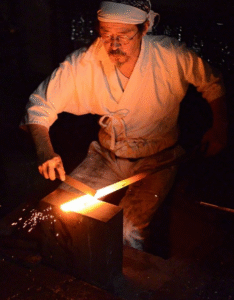Why Ancient Warriors Used Curved Blades: The Science Behind the Katana

The katana stands as one of history’s most recognizable weapons, its distinctive curved blade cutting through centuries of legend and lore. This masterpiece of Japanese craftsmanship represents far more than a simple tool of war—it embodies the perfect marriage of form and function, where every curve serves a calculated purpose.
But why did ancient Japanese swordsmiths abandon straight-blade designs in favor of the katana’s iconic curvature? The answer lies in a fascinating blend of battlefield innovation, metallurgical mastery, and the evolving demands of samurai warfare. Understanding the katana’s curved design reveals not just superior engineering, but the very soul of Japanese martial philosophy.
From the bustling katana UK market to martial arts dojos worldwide, enthusiasts continue to marvel at this weapon’s enduring appeal. The curved blade that once dominated medieval battlefields now captivates collectors and practitioners who recognize the genius embedded in its distinctive shape.
The Evolution From Straight to Curved: A Historical Journey
Japanese sword evolution tells a compelling story of adaptation and refinement. Early Japanese swords, heavily influenced by Chinese straight-blade designs, dominated the battlefield during the Heian period. These chokuto—straight, double-edged swords—served adequately for infantry combat but revealed limitations as warfare evolved.
The transformation began around the 9th century when Japanese swordsmiths started experimenting with subtle curves. This wasn’t mere aesthetic choice but practical innovation driven by changing combat requirements. Chinese sword influences gradually gave way to uniquely Japanese solutions as smiths discovered the mechanical advantages of curved geometry.
Archaeological evidence shows this transition wasn’t sudden but gradual, with early curved swords displaying only slight bends. Master swordsmiths like those of the Yamato and Yamashiro schools refined these techniques over generations, each iteration bringing the blade closer to the katana’s perfected form. The result was a weapon that would define samurai culture for over eight centuries.
Horseback Warfare: The Primary Driver of Curvature
The rise of mounted samurai warfare fundamentally changed Japanese sword requirements. Fighting from horseback demanded weapons optimized for slashing attacks rather than thrusting motions. The katana’s curvature proved perfectly suited to this combat evolution, transforming cavalry charges into devastating displays of cutting power.
Curved blades excel at delivering sweeping cuts while maintaining proper edge alignment throughout the strike. When a mounted warrior swung his katana, the blade’s geometry naturally followed the arc of his arm movement, maximizing cutting efficiency against foot soldiers below. This mechanical advantage meant samurai could dispatch multiple opponents with fluid, continuous motions.
The curve also enhanced the psychological impact of cavalry charges. The distinctive whistle of a curved blade cutting through air, combined with its intimidating silhouette, often broke enemy formations before physical contact occurred. Japanese swords became weapons of both physical and mental warfare, their very appearance striking fear into opposing forces.
Engineering Excellence: How Curves Create Superior Blades

Stress Distribution and Durability
The katana’s curvature isn’t merely functional—it’s a masterpiece of metallurgical engineering. Curved geometry distributes stress more evenly across the blade during impact, significantly reducing the likelihood of catastrophic failure. When a straight blade strikes an object, stress concentrates at the point of impact, often resulting in chips, cracks, or complete breaks.
Japanese Masamune Swords swordsmiths understood this principle intuitively, crafting blades that channeled force along the entire curve rather than focusing it at a single point. This engineering insight allowed samurai swords to withstand repeated combat use while maintaining their structural integrity. The curve essentially transforms the blade into a sophisticated spring system, absorbing and redirecting energy efficiently.
Modern metallurgical analysis confirms what ancient smiths knew through experience: curved blades demonstrate superior fatigue resistance compared to straight alternatives. This durability factor proved crucial during extended campaigns where weapon maintenance opportunities were limited.
Cutting Efficiency Optimization
The science behind cutting reveals another advantage of curved blade geometry. When slicing through materials, the katana’s curve creates a progressive cutting action rather than attempting to sever everything simultaneously. This reduces the force required for successful cuts while increasing overall efficiency.
Each section of the curved blade contacts the target sequentially, concentrating cutting pressure at the point of contact while the rest of the blade provides leverage. This principle, known as “draw cutting,” explains why curved swords can slice through materials that would stop straight blades of equivalent weight and sharpness.
Japanese sword masters exploited this advantage through specific cutting techniques that maximized the blade’s natural geometry. Traditional iaido forms demonstrate how proper technique combined with optimal blade curvature creates devastating cutting power with minimal effort.
Enhanced Drawing Speed
The tactical advantage of quick sword deployment cannot be overstated in close combat situations. The katana’s curve facilitates rapid drawing from the scabbard, allowing samurai to transition from peaceful stance to combat readiness in milliseconds. This speed often meant the difference between life and death in surprise encounters.
When drawing a curved blade, the natural arc of the withdrawal motion aligns perfectly with the sword’s geometry. Straight swords require additional movements to achieve proper cutting position, while the katana emerges ready for immediate action. This mechanical advantage gave samurai warriors a crucial edge in dueling situations where every fraction of a second mattered.
The famous “iaijutsu” quick-draw techniques developed specifically to exploit this geometric advantage, creating fighting styles that were uniquely Japanese and perfectly suited to the katana’s curved design.
The Katana’s Modern Legacy in the UK and Beyond

Contemporary appreciation for Japanese swords has created a thriving katana UK market, where collectors and martial artists seek authentic pieces that embody centuries of craftsmanship tradition. Modern katana swords serve multiple purposes: training tools for martial arts practitioners, display pieces for history enthusiasts, and functional art for those who appreciate masterful metalwork.
UK regulations regarding katana ownership reflect their continued relevance and appeal. While decorative pieces remain widely available, functional katana swords require proper documentation and responsible ownership. This legal framework ensures that these historical weapons receive the respect and careful handling they deserve.
Martial arts schools across Britain incorporate traditional katana techniques into their curricula, teaching students to appreciate not just the physical aspects of swordsmanship but the philosophical principles embedded in Japanese blade culture. The curved sword continues to serve as a bridge between ancient wisdom and modern practice.
The Enduring Wisdom of the Curve
The katana’s curved blade represents one of history’s most successful weapon designs, a testament to the innovative spirit of Japanese swordsmiths who transformed battlefield requirements into engineering excellence. Every element of the curve serves multiple purposes: enhancing cutting efficiency, improving durability, enabling rapid deployment, and optimizing cavalry combat effectiveness.
Understanding why ancient warriors chose curved blades illuminates broader principles about function-driven design and the importance of adapting tools to their intended environment. The katana succeeds because its form follows function so perfectly that the two become inseparable—the very essence of masterful craftsmanship.
Whether displayed in a collector’s cabinet, wielded in martial arts training, or studied for historical insight, the katana continues to teach valuable lessons about innovation, adaptation, and the pursuit of perfection. Its curved blade carries forward the wisdom of countless generations, proving that the best designs transcend their original purpose to become timeless examples of human ingenuity.




